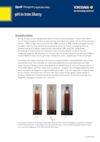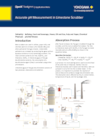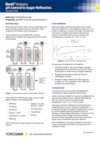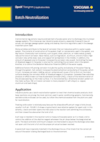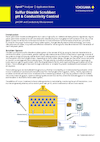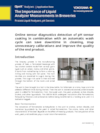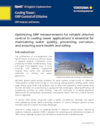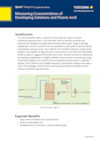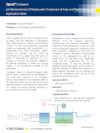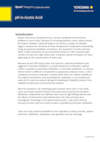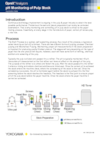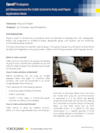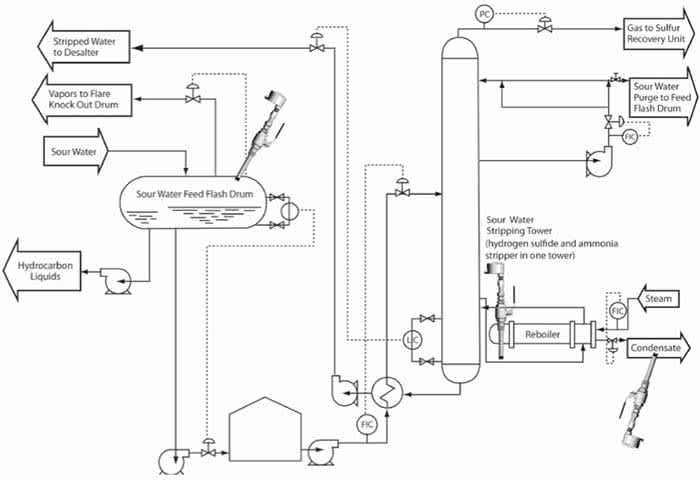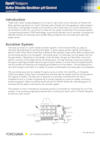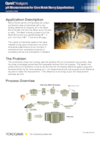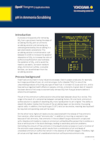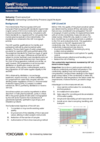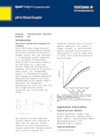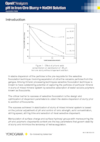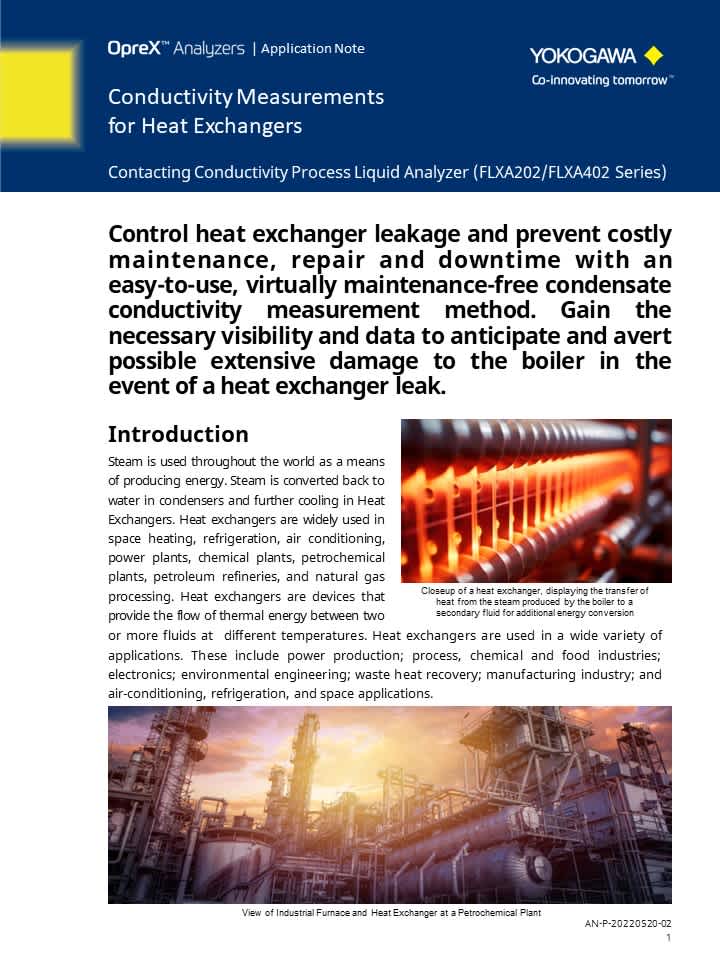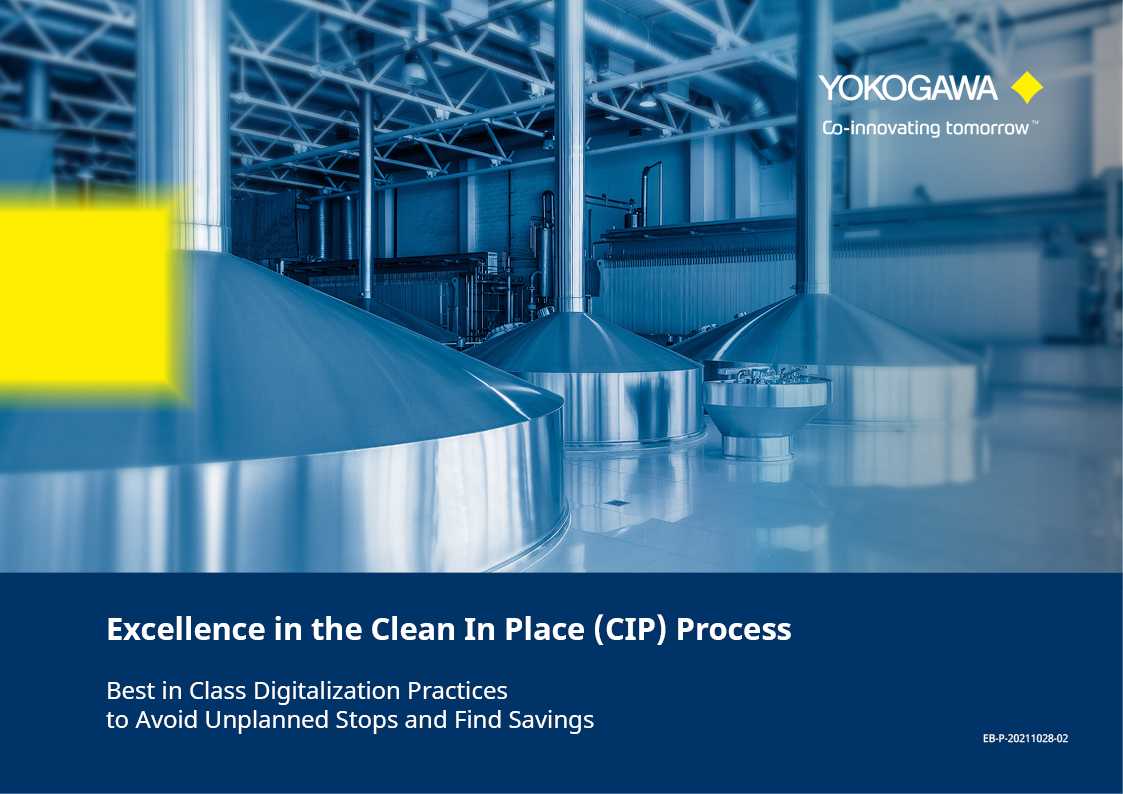The FLXA402 offers multiple connection possibilities, eliminating the need for multiple analyzers and providing greater flexibility. This four-wire analyzer includes a color HMI and an easy touchscreen operation with a simple menu structure in 9 languages for simple and efficient setup and configuration.
With its modular design, the FLXA402 analyzer offers a range of measurement choices with the respective sensor module, including pH/ORP, resistivity/conductivity (SC), inductive conductivity (ISC), percent concentration, dissolved oxygen (DO), and 4-20mA input. Dual sensor measurements offer additional functionalities, such as a calculated data function that can be customized.
Details
What Are the Benefits of the Multi Channel 4-Wire FLXA402?
Support of Up to Five Sensors
The FLXA402 can connect up to five sensors, realizing interruption-free measurement even during maintenance. Multiple sensor measurement offers additional functionalities including a variety of calculated data as well as the option to program the analyzer as a redundant system.
Advanced Functions
With the FLXA402, one analyzer can accept: pH/ORP, Contacting Conductivity (SC), Inductive Conductivity (ISC), Dissolved Oxygen (DO), and Optical Dissolved Oxygen Sensors with self-diagnostic capabilities. Additional functions include:
- Continuous measurement of sensor impedance, asymmetric potential, and slope, and continuous monitoring for electrode contamination/damage, burnout, and a decline in measurement liquid level (ex. pH Analyzer)
- Online Sensor Wellness checking for predictive maintenance
 Expert Guide: Clear Touch Panel Display for Improved Operability
Expert Guide: Clear Touch Panel Display for Improved Operability
The FLEXA™ series analyzer provides improved operability with intuitive touchscreen operation, featuring a clear display and user-friendly indication with 9 languages. The display of sensor status and estimated maintenance time improve efficiency. The interactive screen is housed in a robust aluminum die-cast housing.
Advanced Flexibility: Modular Design for Increased Scalability
The FLEXA™ series analyzer features a modular design with replaceable sensor modules, enabling the construction of a variety of systems. FLXA402 allows for the connection of up to five possible sensors resulting in a reduction in CAPEX and OPEX.
 Preparing for the Future
Preparing for the Future
Industrial automation is moving toward SMART products, with sensors changing from analog to digital SMART. This transition can affect plant operations and take time to fully implement.
In addition to being a high performance standalone analyzer, the FLXA402 is also a component of the new Yokogawa SENCOM 4.0 Platform, a SMART sensor system that simplifies in field maintenance and calibration. With the SENCOM 4.0 Platform, upgrading to the next generation SMART product is easy, and an upgrade transfer can be done at any time with little impact on operations.
Data Mobility
SD card or Ethernet for easy data transfer and remote service, allowing for more in-depth process analysis.
Resources
Yokogawa's Optical Dissolved Oxygen Sensors offer reduced maintenance time and longer maintenance cycles for efficient process optimization.
Questionable flow and conductivity measurements during CIP could raise questions about food quality and safety.
Wet scrubbers are used in utilities, paper mills, and chemical plants to remove sulfur dioxide (SO2) and other pollutants from gas streams. Undesirable pollutants are removed by contacting the gases with an aqueous solution or slurry containing a sorbent. The most common sorbents are lime, Ca(OH)2, and limestone, CaCO3.
SMART digital sensors and advanced data management software enhance reliability and process safety.
Yokogawa’s Process Liquid Analyzers series help pigment producers achieve a more reliable and accurate analysis of pH during industrial bioprocesses, improving product quality with less total operation costs.
In today’s tightening orange juice market, facilities must improve efficiency to deliver high-quality products. With that goal in mind, a leading U.S. juice and citrus processor uses or sells each part of the orange. Nothing goes to waste. In the drive to improve efficiency, the juice and citrus products producer needed a reliable partner to help determine ways to reduce maintenance costs and deliver high returns. The producer selected Yokogawa products such as the EJAC80E Diaphragm Seal System with DPharp sensor technology for level control and monitoring, ADMAG AXG magnetic flow meters (magmeters) for flow measurement, and FLXA402 analyzers for pH and conductivity monitoring.
After extraction from sugar cane or sugar beets, the juice must be purified to remove the many other organics and minerals that accompany it. The processing to accomplish this is heavily dependent on reliable pH measurement and control as illustrated.
For control of batch neutralization, a pH measurement coupled with a timer-controlled chemical feed scheme provides very satisfactory results.
This system can be adapted for either acid waste or alkaline waste neutralization.
Dairy wastewater is a mixture of organic compounds, suspended solids, fats, and bacteria that can produce a film or coating on equipment in the process.
Having too much oxygen in the process is not a problem for the biological system; however the cost for generating the oxygen is one of the largest expenses. By obtaining a good representative average of the dissolved oxygen present in the basin could save the plant large amounts of money. For this reason multiple measurements points are sometimes put into place.
Where and why are the pH Measurements important in a brewery? No one wants a skunky beer. pH measurements in the wort, during mashing/souring the malt, and in the yeast enzymes are critical.
Optimizing ORP measurements for reliable chlorine control in cooling tower applications is essential for maintaining water quality, preventing corrosion, and ensuring work health and safety.
Conductivity measurement can be used as a reliable indicator of the real-time brine concentration. Using an online process analyzer removes the need for timely grab sample analysis.
Measurement of pH in high purity water presents many difficulties. Yokogawa's pH instrument's design success comes from addressing the unique challenges of the application.
Problems at the wet end of a paper machine can rarely be corrected downstream. That is why monitoring and controlling pH in pulp stock is critical to the paper-making process. Essentially, at every stage in the manufacture of paper, correct pH values play a vital role. Variations in the pH value at the headbox have a negative effect on the quality of the paper produced. Proper monitoring ensures minimizing plugging and fouling problems that occur with pH measurements in paper mills.
Ion Exchange is a method for the exchange of ions between two electrolytes or between an electrolyte solution and a complex molecule. In most cases the term is used to denote the processes of purification, separation, and decontamination of aqueous and other ion-containing solutions with solid polymeric or mineralic ion exchangers.
Process liquid analyzers such as pH meters, conductivity meters, ORP meters, and density meters play an important role at electrolysis plants in the control of concentrations of various process solutions. This requires both precision and stability under harsh conditions that include highly corrosive substances, high temperatures, and many impurities.
In a semiconductor plant, a variety of chemicals are used in various manufacturing processes. The chemicals used for specific purposes are produced by diluting raw liquid with demineralized water using in diluting equipment, and the control of the concentration at this point is performed by conductivity measurement.
The treatment of wastewater from pulp and paper plants is a serious environmental concern. Yokogawa's submersion holder with an ultrasonic+air-jet cleaner (customized product) can reduce the manual cleaning frequency to just once every one or two months.
Wastes have been considered to be a serious worldwide environmental problem in recent years. Because of increasing pollution, these wastes should be treated. However, industrial wastes can contain a number of valuable organic components. Recovery of these components is important economically. Using conventional distillation techniques, the separation of acetic acid and water is both impractical and uneconomical, because it often requires large number of trays and a high reflux ratio. In practice special techniques are used depending on the concentration of acetic acid.
The kraft process, also known as kraft pulping or the sulfate process, is a technology for conversion of wood into wood pulp that consists of almost pure cellulose fibers. Today, the kraft process is used in approximately 80% of paper production.
Clean-in-place (CIP) is the system designed for automatic cleaning and disinfecting in the food & beverage, pharmaceutical, and chemical industries. Tanks and piping are cleaned and sterilized with various cleaning solutions, fresh or hot water, or steam after manufacturing products is completed.
Cyanide-bearing wastewater from mining and electroplating facilities and certain types of chemical plants is toxic and must be treated by oxidation with chlorine or chloride to bring the cyanide concentration within regulatory limits.
Industry:Electrical and Electronics
Continuous technology improvement is ongoing in the pulp & paper industry to obtain the best possible performance. Problems at the wet end (stock preparation) can rarely be corrected downstream. That is why monitoring and controlling pH in pulp stock is critical to the paper making process. Essentially, at every stage in the manufacture of paper, correct pH values play a vital role.
The quality of paper for printing or writing should be high and it depends on many parameters. Cobb is one of the parameters, which requires control. Using a retractable fitting, this optimum pH level can be achieved by using Yokogawa's 4-wire pH Analyzer with a suitable, retractable fitting and sensor. Since a separate controller is not required for the dosing pump, this solution provides a cost-saving.
Reverse osmosis (RO) is a separation process that uses pressure to force a solution through a membrane that retains the solute on one side and allows the pure solvent to pass to the other side. More formally, it is the process of forcing a solvent from a region of high solute concentration through a membrane to a region of low solute concentration by applying a pressure in excess of the osmotic pressure.
Wastewater from electroplating facilities and certain types of chemical plants contains toxic forms of hexavalent chromium such as chromate and dichromate. The hexavalent chromium in this wastewater must be reduced before the water can be discharged. This requires a two-step process: hexavalent chromium (CR6) is reduced to trivalent chromium (CR3); and CR3 is precipitated as chromium hydroxide.
Industry:Electrical and Electronics
Removal of free oil and grease from a wastewater stream reduces the potential for equipment problems downstream. Three forms of oil are encountered in wastewater treatment at a refinery: Free Oil, Emulsified Oil, Dissolved Oil.
Sour Water is the wastewater that is produced from atmospheric and vacuum crude columns at refineries. Hydrogen sulfide and ammonia are typical components in sour water that need to be removed before the water can be reused elsewhere in the plant.
Power plant boiler houses designed to burn coal or high sulfur oil are required by Federal and State pollution regulations to "scrub" (remove) sulfur dioxide from flue gasses to meet emission limits. SO2 in flue gasses is known to be harmful to the environment, as it is one contributor to the formation of acid rain. pH control is critical for the proper functioning of the scrubber system.
Yokogawa’s conductivity transmitters and converters possess USP functions that make this seemingly complex and troublesome requirement pain-free and automatic.
In flue gas desulfurization systems that use magnesium hydroxide (Mg(OH)2) slurry, the consumption of the desulfurization agent (Mg(OH)2) is controlled by using online pH analyzers. A great concern in the pH measurement is heavy staining of the pH electrodes by the Mg(OH)2 slurry. To ensure accurate measurement, frequent cleaning of the electrodes with an acid is required, adding to both maintenance workload and cost.
Industry:Chemical, Power
To defray energy costs, many industrial plants have their own boilers to generate steam to produce a portion of their energy needs. In addition to generating power, the steam may also be used directly in plant processes or indirectly via heat exchangers or steam jacketed vessels.
To technology in iron & steel industry is continuously improved to obtain the best possible performance. The improved plant performance gives rise to the higher quality improvement and lower cost, and simultaneously environmental friendly plant operation.
How integrating advanced pH sensors with temperature compensation, chemical resistance, and a dynamic mounting system can prevent fouling and damage.
Fish are totally dependent upon water to breathe, feed, grow, maintain a salt balance, and reproduce. Water quality determines the success or failure of an aquaculture operation.
In stable dispersion of fine particles is the pre-requisite for the selective flocculation technique involving separation of ultra-fine valuable particles from the gangue. Among mineral processing techniques selective flocculation technique is known to have outstanding potential of capturing the particles of particular mineral in slurry of mixed mineral system by selective adsorption of water soluble polymers known as flocculants.
Heat exchangers are devices that provide the flow of thermal energy between two or more fluids at different temperatures. Heat exchangers are used in a wide variety of applications. These include power production; process, chemical and food industries; electronics; environmental engineering; waste heat recovery; manufacturing industry; and air-conditioning, refrigeration, and space applications. Yokogawa offers a means to control heat exchanger leakage and prevent costly maintenance, repair and downtime with an easy-to-use, virtually maintenance-free condensate conductivity measurement method.
Read this eBook to learn how to best leverage the latest measurement instrumentation to avoid incidents and improve productivity. You will also find valuable information about overcoming common CIP challenges and stories of success.
Downloads
Brochures
- FLXA402 4-Wire Liquid Analyzer, SA11 SENCOM Smart Adapter (2.9 MB)
- Importance of Analyzer Maintenance (194 KB)
- SENCOM 4.0 Platform (4.3 MB)
- Yokogawa in the Food and Beverage Industry (5.9 MB)
- Benefits of SENCOM 4.0 for Pulp & Paper Industry (995 KB)
- Liquid Analyzers in the Water Industry
- Co-innovating on Best-in-Class Analytical Solutions (318 KB)
Instruction Manuals
- FLXA402 4-Wire Converter Protection of Environment (Use in China) (167 KB)
- FLXA402 4-Wire Converter Start-up and Safety Precautions (1.6 MB)
- WTB10-DO1,-DO2,-DO3,-DO4 Terminal Box (687 KB)
- FLXA402 4-Wire Converter Installation and Wiring (Introduction and General Description) (4.9 MB)
- FLXA402 4-Wire Converter Operation of Converter (5.0 MB)
- FLXA402 4-Wire Converter Operation of pH/ORP (1.5 MB)
- FLXA402 4-Wire Converter Operation of SC (1.6 MB)
- FLXA402 4-Wire Converter Operation of ISC (1.6 MB)
- FLXA402 4-Wire Converter Operation of DO (1.7 MB)
General Specifications
- FLXA402 4-Wire Converter (1.5 MB)
Technical Information
- SENCOM 4.0 Platform: Grounding (3.6 MB)
- FLXA402 4-Wire Converter HART Communication (1.0 MB)
- FLXA402 Relay Connection (591 KB)
- FLXA402 4-Wire Converter MODBUS Communication (693 KB)
- Conductivity Analyzer Guide (992 KB)
- Contacting Conductivity sensor selection guide (1.6 MB)
- Boiler Life Cycle Considerations
Certificates
- FLXA402 FM (289 KB)
Engineering Tools
- FLXA402 4-Wire Converter (603 KB)
Videos
Looking for more information on our people, technology and solutions?
Contact Us


